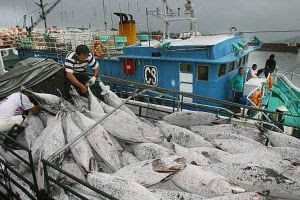by Eileen Hee
 TUNA is a big business and can play a significant role as a catalyst for the nation's economic growth.
TUNA is a big business and can play a significant role as a catalyst for the nation's economic growth.
Malaysian International Tuna Port (MITP) Sdn Bhd chief executive director Datuk Annuar Zaini Binyamin said the industry had tremendous potential.
“The industry is estimated to worth RM40bil, with a total industry volume of 6.2 million tonnes per year,” he told StarBiz in an interview.
“In recent years, tuna has become more than just a basic food item. Its high nutritional value has led to increased consumption and popularity, especially with the opening of sushi bars in major cities worldwide,” Annuar said.
He added that global tuna consumption was about RM100bil a year. However, he said Malaysia was lagging in tapping this lucrative industry.While Malaysia's tuna export was estimated at only RM60mil annually, Annuar said MITP, through its various initiatives, planned to catch up with other Asian tuna players like Thailand, Singapore and Indonesia.
He said some of the initiatives to develop the tuna industry would be to expose Malaysia as a viable landing and export hub to international commercial tuna vessels.
“MITP has been participating aggressively in international conferences and exhibitions involving some of the biggest players in the global tuna market,” Annuar said.
He said MITP would also invest in machineries for the catching, shipping, trading and exporting of tuna.
On the outlook for the tuna industry, Annuar said consumption and production in Asia was not a novel venture.
“In traditional Japanese and Taiwanese communities, tuna has formed a major part of their diet and subsistence for over 1000 years,” he said.
Since 1950s, Japan and Taiwan have been the biggest fresh and chilled tuna producers and consumers in the world, defeating traditional counterparts in Western Europe where tuna has been traded commercially from as early as the 18th century.
“Globally, tuna consumption, catch and production has been a prominent industry in Spain, Germany and Italy, with Spain being the third-biggest canned tuna producer in the world and German recording a history of tuna consumption since the 15th century,” he said.
However, in the last 25 years, the United States has become the world's leading market for canned tuna production and consumption, providing room for the Asian Tuna export, Annuar said.
“Malaysia was among the first prominent tuna-landing hub in Asia from the 1960s to 1980s.
“Since then, it has lost this position to fishery ports from neighbouring countries that have spurred the development of their fishing technology and tuna-landing infrastructure,” he said.
According to Annuar, the Asian tuna industry still faces many challenges.
“The global trend and market for tuna is evolving. Traditional monopolies are constantly challenged and new markets are fast emerging ,” he said, adding that new markets are arising in the Middle East and China.
He added that with the advent of technology and better scientific knowledge of tuna stock, preservations, migration and breeding patterns, new alternative fishing grounds could also be studied and tapped.
Annuar said better infrastructure and development plans, coupled with more efficient port management and operations, are needed in ports in South-East Asia.
“MITP is expected to accommodate tuna vessels as large as 1,000grt by 2010, allowing more tuna landings and exports from Malaysia,” he said.
No comments:
Post a Comment